Cities taking on the energy crisis

Russia’s attack on Ukraine in February 2022 triggered shock waves in global energy markets, leading to price volatility, supply shortages, security issues and economic uncertainty. It compounded the need for fundamental policy changes to end our reliance on fossil fuels, made more acute in Europe due to its reliance on Russian supplies. At city level, it spurred rapid actions over the last year to counteract the rising cost of living and to support people and businesses alike.
Cities responded rapidly, taking bold steps to reorganise services, reallocate budgets, and shield the most vulnerable groups of people through targeted social measures. Energy poverty, which before the war already affected around one in ten Europeans according to Eurostat figures, is now rising fast in many cities. The public transport sector, which was hard hit by the Covid-19 pandemic, is now facing significant increases in running costs. Similarly, inflation puts local SMEs in severe difficulties, and public facilities, such as cultural institutions and sports institutions were closed or only partially kept open as a step to save energy and reduce costs in short-term emergency measures.
With a further short and medium-term focus to reduce energy demand, which has been helped by higher prices; the long-term vision for the EU must be to achieve energy independence by accelerating the roll out of renewable energy systems and dramatically cutting energy consumption. Given that around 70% of total global CO2 emissions are produced in urban areas, cutting Europe’s dependence on fossil fuels will not be possible without cities on board.
Russia’s attack on Ukraine in February 2022 triggered shock waves in global energy markets, leading to price volatility, supply shortages, security issues and economic uncertainty. It compounded the need for fundamental policy changes to end our reliance on fossil fuels, made more acute in Europe due to its reliance on Russian supplies. At city level, it spurred rapid actions over the last year to counteract the rising cost of living and to support people and businesses alike.
Cities responded rapidly, taking bold steps to reorganise services, reallocate budgets, and shield the most vulnerable groups of people through targeted social measures. Energy poverty, which before the war already affected around one in ten Europeans according to Eurostat figures, is now rising fast in many cities. The public transport sector, which was hard hit by the Covid-19 pandemic, is now facing significant increases in running costs. Similarly, inflation puts local SMEs in severe difficulties, and public facilities, such as cultural institutions and sports institutions were closed or only partially kept open as a step to save energy and reduce costs in short-term emergency measures.
With a further short and medium-term focus to reduce energy demand, which has been helped by higher prices; the long-term vision for the EU must be to achieve energy independence by accelerating the roll out of renewable energy systems and dramatically cutting energy consumption. Given that around 70% of total global CO2 emissions are produced in urban areas, cutting Europe’s dependence on fossil fuels will not be possible without cities on board.
Multilevel challenges
The European Union responded to this energy crisis with a series of measures under the RePowerEU plan, aimed at putting Europe on a path to energy independence from Russia as soon as possible. It both boosts existing legislation, including new targets for renewable energy production, and sets out an ambition to double the EU’s solar photovoltaic capacity by 2025 and install 600GW by 2030 by speeding up the permit process for certain renewable energy installations.
City authorities are at the forefront of efforts to support EU and national climate objectives by reducing consumption, scaling up renewable energy projects and democratising the provision of clean energy, but must be supported and empowered while they implement those policies. Many Eurocities member cities have already taken fast short-term measures to keep on track both in the ongoing context of the energy crisis, as well as in the broader ambitious climate framework of the EU. For example, Berlin quickly put an energy saving package in place, aiming to save at least 10% of public sector energy consumption, including in schools, universities, and court houses. This included a 17 degree policy in public buildings during evenings and night-time. The city also set up a Crisis Fund to support households through an energy relief package.
At the same time, at local level, city leaders must fulfil a double role: getting individuals and other local actors on board for the necessary and urgent changes required in changing behaviour and consumer choices; and working with other levels of government, especially nationally, to ensure that the implementation of energy transition measures is as smooth as possible.

Considering your local constraints, do you foresee you will be able to contribute to your national energy reduction efforts?
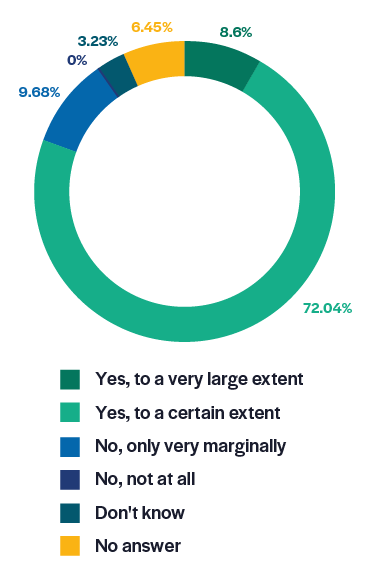
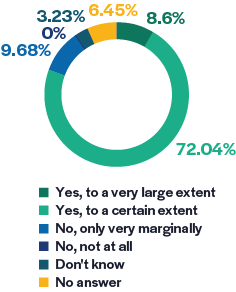
Did your city receive financial support from your national government?
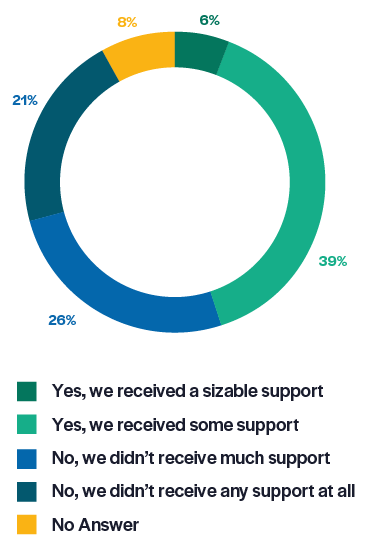
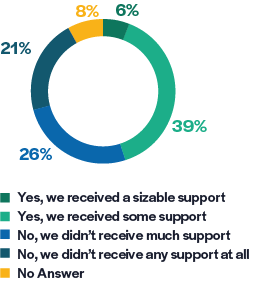
The revision of the National Energy and Climate Plans, currently under submission, should provide a clear roadmap for how those goals will be achieved in practice. However, they won’t be successful unless cities are really involved in the design and the implementation of the actions.
Despite this, the top three challenges mayors report being faced with when looking at ways to speed up the energy transition in their city are access to finance, considering how to best make buildings energy efficient, and dealing with a lack of administrative capacity locally. In all of these areas, some of the most common comments received from mayors are about developing the appropriate technical and financial frameworks at national and European levels to streamline the work done at local level.
When it comes to access to finance, the main challenge mentioned by mayors is a lack of financial resources or financing lines to address the high level of investments required for the energy transition. With less ability to raise the required sums locally, many cities find it necessary to look firstly to national schemes for support. A proposed golden rule in the EU’s fiscal framework would offer greater flexibility to long-term investment at the local level, by excluding investments into the green or digital transitions. In addition, with a focus on increasing the total amount of finance and investments from alternative sources, there is a strong need to scale up existing solutions from pioneering cities. This requires building the capacity of many local administrations to get them more comfortable with the way private investment is structured. For example, new skills may need to be brought in, or developed within a city administration.
Cities at the forefront of the fight against the Energy Crisis
As we emerge from the worst energy crisis in a generation, it is a timely opportunity to look back on our collective achievements over the past year. 2022 was an extraordinarily difficult one – driven primarily by Russia’s unprovoked war on Ukraine and the deliberate attempt to turn energy into a political weapon.
With REPowerEU, the European Union came out with a decisive plan to respond to the energy challenges and to accelerate the EU’s clean energy transition. There is no doubt that the energy transition we see at Union level could not have been achieved without the commitment of cities and the contribution of citizens at local level.
This year, the focus is on moving from crisis response to actions which improve each citizen’s life in the longer term. This will be achieved if the EU, national and local levels concentrate efforts on creating a clean, secure and affordable energy system.
Our REPowerEU plan builds the fundament for this transition. Already last year, we made some incredible progress: Measures taken under the plan have helped us to significantly reduce our dependence on Russian fossil fuels. And it has shielded our citizens from the worst of the market volatility.
Through all of this, the local authorities and citizens of our cities and towns have played an indispensable role. Last year, we replaced a large share of gas with an additional 50 GW of renewable power generation and households were one of the main achievers of this. Europeans have demonstrated remarkable initiative and leadership on renewables in recent years, installing millions of solar photovoltaic panels on their roofs, putting heat pumps in their homes and turning to electric vehicles. Local authorities and citizens have once again proven their readiness and resilience.
On top of delivering ambitious local climate solutions, cities have put in place immediate low-cost actions to reduce energy demand in public facilities, while supporting the most vulnerable households and local business. The Covenant of Mayors’ Cities Energy Saving Sprint, for instance, implemented in over 50 cities, offers a prime example of how local authorities mobilised themselves with energy saving tips on heating, lighting and mobility.
Despite the achievements, all players need to cement this direction of travel. The Commission is determined to be bolder on this front.
Our REPowerEU plan aims to more than double the total renewable electricity generation capacity by 2030, compared to 2021. Measures such as the EU Commission’s proposed reform of the electricity market design will support cities in achieving this heightened level of ambition and empower and protect consumers. New rules will ensure that all consumers benefit from the low costs of renewables directly in their energy bills, but crucially for cities, towns and villages, the reform will empower citizens to share clean, renewable energy directly within their local communities.
When it comes to energy efficiency, municipalities each manage a large portfolio of building stock (both public and commercial), and have competences in urban planning, built infrastructure, public lighting and transport. They are therefore best placed to be drivers of reform in achieving our ambitious new targets for 2030 and 2050 set by the recently enhanced Energy Efficiency Directive.
I know that energy and climate remain high on the agenda for towns and cities across Europe. It’s essential that we consolidate our achievements of the past year and move towards long-term structural solutions. As the closest level of government to our citizens, I am confident that local authorities will continue to play a vital role in this regard. Our energy security depends on it.

By Kadri Simson
EU Commissioner for Energy
Top challenges mayors face when looking at ways
to speed up the energy transition
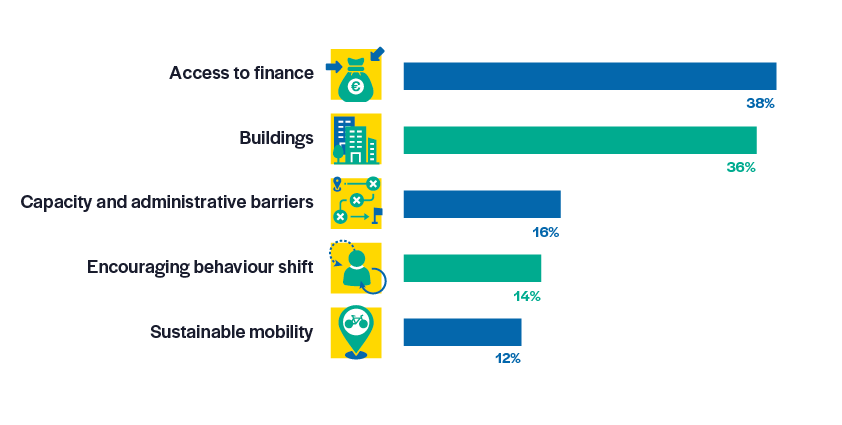
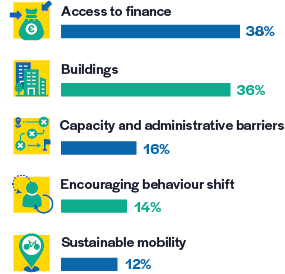
Energy performance of buildings
The revision of the EU’s Energy Performance of Buildings Directive aims to update a 12-year old agreement in line with today’s targets. Given that buildings account for 40% of final energy consumption in the Union and 36% of its energy-related greenhouse gas emissions, local people. Eurocities, together with its member cities, successfully brought messages to ensure that the recast directive better matches cities needs.
Regarding the challenge of building renovations, while financing plays a huge part, mayors face many other issues. Notably, many of the older buildings that are most in need of renovation are privately owned, which requires incentivising owners to make the investments and facilitating participatory processes for collective renovation projects; and other buildings owned by the city may be important for cultural heritage, which can complicate tasks such as where or how to place solar panels so as to conserve the building from both an architectural, technical and aesthetic point of view.

Investment priorities
In their responses to the Eurocities Pulse survey, mayors outlined three clear priorities when it comes to their planned investments to speed up the energy transition of their city: sustainable mobility, building renovations, and developing renewable or green energy sources. While sustainable mobility and building renovation matched almost evenly as mayors’ top priority for the next five years, we also saw that building renovation is deemed to be a bigger challenge, suggesting that city administrations would benefit from more direct support, especially from the national level.
Accelerating the rollout of renewable energy and reducing the fossil fuel consumption in industry and transport have also been identified as key priorities within the National Recovery and Resilience Plans – the financial package levied by the EU to help member states enact their post Covid-19 recovery.
Given that most cities received only some or little support to deal with their increased municipal energy costs, according to data collected by the Eurocities Pulse survey, accessing other sources of financing like this is important. There is a strong need to better target existing loan facilities to the needs of cities with smaller loans and to set up advisory facilities to support business case development and project bundling.
For example, Rome, Naples and Milan received a joint tender under the National Recovery and Resilience Plan to encourage the use of public transport. In Milan this will include creating one digital platform to connect all operators offering shared bikes, cars, scooters and other means of travel in the city.
Two trends among cities, noted as the fourth and fifth investment priorities, are to replace public lighting with LEDs, thus saving energy, and to engage communities directly in the production of energy. The concept for local energy communities encourages energy production from smaller energy sources, such as via the installation of solar panels, that can then be sold back into the grid by a person or institution that produces more than needed. This surplus can be redistributed via the energy community of which different people or organisations may be a member.
Top priorities for cities to plan investments
to speed up the energy transition
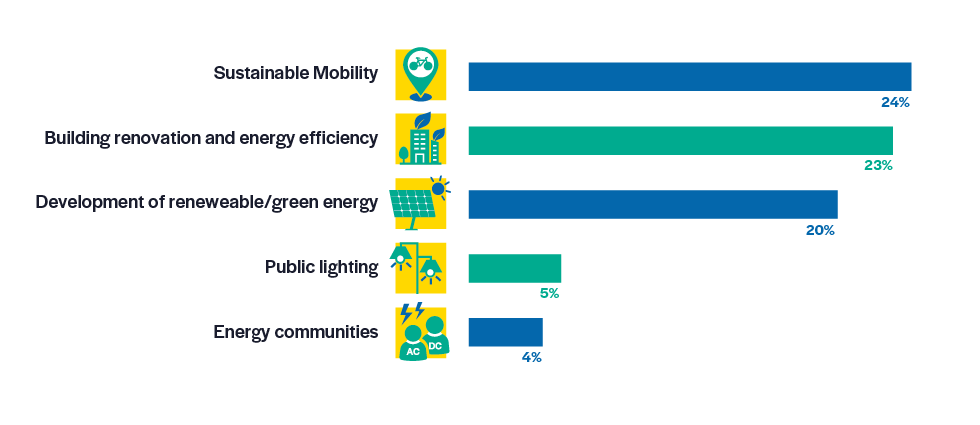
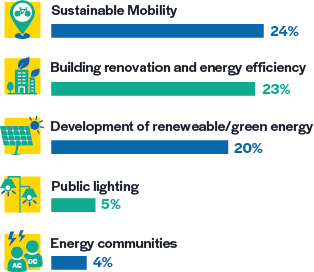
Energy poverty
75% of EU buildings are deemed energy inefficient, and up to one in four households in Europe cannot afford to adequately heat, cool, or light their homes. Against the backdrop of Russia’s illegal invasion of Ukraine, the rocketing energy prices put an even higher number of people at risk of energy poverty.
Energy poverty is a multi-dimensional phenomenon, considered to be caused by a combination of low-income, high-energy expenses, and poor energy efficiency in buildings. Next to a huge impact on the financial situation of the household, the negative effects of energy poverty on a person’s physical and mental health, wellbeing, and education can be severe and can lead to social exclusion.
The EU has been addressing this issue in various legislative and non-legislative initiatives, most recently in the context of its climate policies and energy transition. The Energy Efficiency Directive and the European Performance of Buildings Directive strengthened provisions to alleviate energy poverty alongside efficiency efforts. Moreover, the ‘renovation wave’ initiative under the European Green Deal aims to boost structural renovation in private and public buildings, while the Social Climate Fund includes households in energy poverty among its main beneficiaries.
Cities are crucial actors to implement some of those measures – i.e. driving energy efficiency improvements, boosting energy communities, supporting local people through one-stop shops, or offering support to cover the energy expenditure of low-income households.
This is the case in Valencia’s Energy Office, which works closely with the city’s social services to ensure that those at greatest risk of energy poverty are not left out in the cold.

One-stop shops
Locally established one-stop shops are already vital to speed up EU building renovation rates. One-stop shops raise awareness and encourage residents to embark on building renovation plans while avoiding the time-consuming renovation process of bureaucracy and hidden costs. Most importantly, they provide free and trusted advice to vulnerable households, offering them an opportunity to renovate their houses while tackling energy poverty. However, to set up and run innovative local initiatives such as one-stop shops, especially to benefit more vulnerable and at-risk households, most cities still need access to technical assistance and means to increase their local capacities (particularly during the project development phase) from both the national and EU level..
